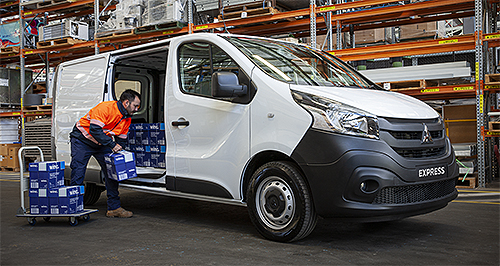Driven: Mitsubishi targets fleets with new Express

MITSUBISHI’S long-awaited reborn Express mid-sized van has fleets and tradies firmly in its sights as it enters showrooms this week priced from $38,490 plus on-road costs, with brand executives gunning for the new model to snag them their “fair share of action” within the 2.5t-3.5t van segment.
Speaking to GoAuto ahead of the Express van’s market introduction, Mitsubishi Motors Australia Limited (MMAL) product strategy senior manager Owen Thomson said that while the light-commercial mid-size van segment was not a major one in terms of overall volume, it was an important business market.
“Within that segment, what’s classified as the FCAI small fleet buyer classification is the largest group of buyers for these vehicles with about 40-50 per cent of sales, so that’s really the group where we’re aiming this vehicle at,” he said.
“In terms of who’s playing in this space, there’s about seven manufacturers in there at the moment, and our target is to just get our fair share of action within this group.”
While Mr Thomson made no bones about wanting a slice of the action, he would not be drawn into translating that action into sales targets, instead citing that the segment as a whole averages about 20,000 sales annually.
“It’s about us having market coverage in the segments that suit us as a manufacturer, that cover the things we think we get the best return,” he said.
It has been seven years since MMAL offered a mid-sized van in Australia, with the Express being the first vehicle the brand has been able to leverage from its alliance with Nissan and Renault, sharing almost all of its DNA with the Renault Trafic.
Such are its ties to the Trafic, the Express is produced in the same plant as its French twin in northern France and is available with broadly the same range of engines and transmissions. The Trafic has one extra engine option not offered in the Express.
For the Express, Mitsubishi is offering either a 103kW/340Nm 1.6-litre twin-turbo diesel engine hooked up to a six-speed manual transmission, or a bigger and more powerful 2.0-litre turbo-diesel good for 125kW/380Nm and paired with a six-speed dual-clutch automatic.
Both engines are four-cylinder units.
Drive is sent to the front wheels regardless of powertrain, with the range consisting of four different variants and two different wheelbases, all based around the single trim level.
At the entry point is the $38,490 GLX short-wheelbase manual, above which is the $40,490 GLX long-wheelbase manual.
Then follows $42,490 GLX SWB automatic, while at the top of range sits the $44,490 GLX LWB automatic.
In terms of sheer size and space, MMAL describes the Express as a “goldilocks” of dimensions with the different wheelbase lengths sitting at the lower and upper ends of this so-called ideal range.
The SWB variants rest on a 3098mm wheelbase and measures 4999mm long, 1956mm wide and 1971mm tall.
The LWB, meanwhile, largely mirrors these dimensions except its longer wheelbase, at 3498mm, sees overall length extend to 5399mm.
At the back end, the SWB has 5.2 cubic metres of cargo space, while the payload capacity is rated at 1150kg for the manual and 1115kg for the automatic.
The LWB offers a cargo volume of 6.0 cubic metres and a maximum payload of 1200kg for the manual and 1150kg for the automatic.
For ease of access, all Express grades come with sliding doors on both sides and dual rear barn doors that open to 180 degrees and have a 90-degree stop fitted to each.
Maximum braked towing capacity is as varied as the payloads, limited to 1630kg on the 2.0 LWB auto but pushing up to 2000kg on the 1.6 manual variants. The 2.0 SWB auto slots in between at 1715kg.
In all variants, the cabin has an extra 43 litres of storage space and is configured with a manually adjustable driver’s seat and two-seat bench for passengers.
The driver is also provided with a fully adjustable steering wheel and a retractable armrest, while standard equipment across the range further includes three cupholders, two-stage remote central locking, Bluetooth and USB-compatible audio system (with DAB radio), air-conditioning, cruise control, rear parking sensors, rubber floor mats and through-loading capability underneath the passenger bench.
The 2.0-litre automatics step things up with a few added niceties including a reversing camera, dusk-sensing headlights, rain-sensing windscreen wipers and foglights.
Safety features include five airbags, hill-start assist, driver blind-spot mirror in the passenger sunvisor, electronic stability and traction control, ABS brakes, and rollover mitigation.
Mr Thomson said there were no plans to offer a mini-bus version, citing a lack of demand for such a model.
“The mini-bus market is very, very small and one of the things we do when we approach a product is we look where the best return is for us when we invest,” he said.
“We see it as the commercial delivery vans and it’s a place where we’ve recently played in, so we see that as where we go into the market.
“We pick where we want to play and this is the clear, obvious place to play along with Triton.”
While the Express hits showrooms this week, its Trafic twin currently has an 8.7 per cent share of the 2.5t-3.5t van segment at the halfway point of the year, recording 784 sales to the end of June – down 21.7 per cent on the first half of last year.
The clear market leader is the Toyota HiAce with a 36.1 per cent share of the category, having sold 3262 examples over the first six months.
2021 Mitsubishi Express pricing*
| GLX SWB | $38,490 |
| GLX SWB (a) | $42,490 |
| GLX LWB | $40,490 |
| GLX LWB (a) | $44,490 |
*Excludes on-road costs